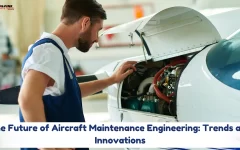How the AME B1.2 Course Meets International Aviation Standards
2024-12-26 10:06How the AME B1.2 Course Meets International Aviation Standards
The aviation industry operates in a highly regulated environment where safety, efficiency, and adherence to standards are paramount. For anyone aspiring to become an Aircraft Maintenance Engineer (AME) specializing in turbine-powered aircraft, the AME B1.2 course is an essential step in acquiring the specialized knowledge and skills needed to work in this critical field. One of the major advantages of the AME B1.2 course is that it adheres to international aviation standards set by authorities such as the European Union Aviation Safety Agency (EASA), the International Civil Aviation Organization (ICAO), and national aviation regulators like the Directorate General of Civil Aviation (DGCA) in India, and the Federal Aviation Administration (FAA) in the United States.
What is the AME B1.2 Course?
The AME B1.2 course focuses on aircraft maintenance with a specialized emphasis on the mechanical and turbine-powered systems of aircraft. This includes the maintenance of jet engines, turboprops, turbofan engines, and other related aircraft systems. The B1.2 qualification is for those aiming to become aircraft maintenance engineers responsible for ensuring that aircraft are safe, efficient, and compliant with stringent aviation regulations.
The training for the AME B1.2 course involves both theoretical learning (covering aviation regulations, systems, and safety) and practical experience (in workshops and on-the-job training), giving students the hands-on skills required to troubleshoot, repair, and maintain turbine-powered aircraft.
International Aviation Standards in the AME B1.2 Course
The global nature of the aviation industry demands that aircraft maintenance engineers adhere to internationally recognized standards to ensure safety, consistency, and interoperability across borders. The AME B1.2 course meets these standards by aligning its curriculum and practices with the following key aviation regulatory frameworks:
1. ICAO Standards and Recommended Practices
The International Civil Aviation Organization (ICAO), a specialized agency of the United Nations, is responsible for establishing global standards for aviation safety, efficiency, and environmental protection. ICAO’s Annex 1 (Personnel Licensing) provides guidelines for licensing maintenance engineers and technicians. The AME B1.2 course is designed to meet or exceed these ICAO requirements for aircraft maintenance engineers, ensuring that graduates have the technical proficiency and knowledge required to meet ICAO’s global standards for safety and airworthiness.
- Compliance with International Standards: ICAO’s standards for training, certification, and continuing professional development are embedded into the AME B1.2 curriculum. This ensures that students are not only prepared to meet national regulations but are also able to adhere to global standards when working on international aircraft fleets.
- Interoperability: Since ICAO’s standards are globally recognized, they ensure that graduates can work anywhere in the world, contributing to a harmonized aviation industry where maintenance standards remain consistent across different regions and jurisdictions.
2. EASA (European Union Aviation Safety Agency)
The European Union Aviation Safety Agency (EASA) plays a crucial role in regulating aviation safety within the European Union. EASA’s regulations are widely adopted beyond Europe due to their thoroughness and high standards. The EASA Part-66 license is a key standard for aircraft maintenance engineers and covers various categories of maintenance, including the B1 (Mechanical) category for turbine-powered aircraft.
The AME B1.2 course is often aligned with EASA Part-66 requirements, particularly for countries within the EU or those that have agreements with EASA. By adhering to EASA standards, the course ensures that students are trained to meet one of the most rigorous aviation standards in the world. Graduates with an EASA-compliant certification can work on aircraft operated by European airlines or those with international routes that require EASA-certificated maintenance personnel.
3. DGCA (Directorate General of Civil Aviation) – India
In India, the DGCA regulates civil aviation and sets the standard for aircraft maintenance engineers through the CAR (Civil Aviation Requirements). The AME B1.2 course in India is designed to meet the DGCA’s licensing standards, specifically for aircraft maintenance engineers working on turbine-powered aircraft. The course follows the CAR-66 guidelines, which mirror international standards while also addressing the specific needs and regulations of the Indian aviation sector.
- Compliance with DGCA’s Requirements: The AME B1.2 program in India ensures that students are familiar with the specific national regulations, procedures, and safety protocols outlined by the DGCA. This makes it easier for graduates to work in India and abroad, with their qualifications recognized by other international regulatory bodies like EASA and the FAA.
4. FAA (Federal Aviation Administration) – United States
The FAA is the authority governing aviation safety in the United States. While the AME B1.2 course is not FAA-specific, it still ensures that students are trained according to the FAA Part 65 standards for aviation maintenance technicians. This means that graduates of the AME B1.2 course are prepared to meet the requirements set by the FAA for maintaining turbine-powered aircraft in the U.S. or any country that follows FAA regulations.
- Global Portability: As the FAA has a significant influence on global aviation standards, the AME B1.2 course prepares students to comply with these standards, enhancing their ability to work for U.S.-based airlines, maintenance providers, or companies that require FAA-certified personnel.
Key Areas Where AME B1.2 Meets International Standards
1. Aircraft Safety and Airworthiness
Aviation safety is at the heart of the AME B1.2 course. The course covers not only the technical aspects of turbine-powered aircraft maintenance but also the safety protocols and airworthiness standards required by international regulatory bodies. These include:
- Routine inspections, checks, and certifications required to ensure that the aircraft meets the global airworthiness standards.
- Maintenance procedures to ensure that aircraft are compliant with global safety regulations, reducing the risk of mechanical failures and enhancing passenger safety.
2. Quality Control and Documentation
International aviation standards emphasize the importance of proper documentation and quality control in aircraft maintenance. Graduates of the AME B1.2 course are trained to:
- Maintain detailed logbooks for every aircraft, recording maintenance activities, repairs, inspections, and modifications.
- Follow quality management systems (QMS) to ensure that all maintenance activities meet global aviation standards for safety and compliance.
These standards are aligned with ICAO, EASA, and other global aviation regulators’ expectations, ensuring that the work of AME B1.2-certified engineers is consistent, reliable, and internationally recognized.
3. Environmental Standards
Aviation is one of the most regulated industries when it comes to environmental impact. International aviation bodies like ICAO and EASA set strict guidelines on emissions, noise, and other environmental factors that maintenance engineers must adhere to. The AME B1.2 course addresses:
- The environmental impact of turbine engines and associated systems.
- How to conduct maintenance in a manner that complies with international environmental standards, contributing to sustainability in the aviation sector.
How the AME B1.2 Course Prepares Graduates for International Careers
The AME B1.2 course offers a globally recognized qualification that allows graduates to work with international airlines, aircraft manufacturers, and maintenance organizations. Here’s how it prepares students for an international career:
1. Recognition Across Borders
As the course adheres to international standards like those set by ICAO, EASA, FAA, and DGCA, the qualifications obtained from an AME B1.2 program are recognized worldwide. This means that graduates can seek work in various countries, working on aircraft operated by airlines or MRO (Maintenance, Repair, and Overhaul) facilities that operate on global flight routes.
2. Increased Job Opportunities
Graduates of the AME B1.2 course can apply for jobs with international airlines, MRO organizations, aircraft manufacturers, and military aviation around the world. With the aviation industry increasingly operating across borders, the demand for certified engineers trained to meet international standards is growing.
3. Transferable Skills
The skills learned in the AME B1.2 course, such as diagnosing and repairing turbine engines, working with advanced avionics systems, and performing airworthiness inspections, are transferable to any country that follows international aviation regulations. This ensures that AME B1.2-certified engineers can easily adapt to different work environments and regulatory frameworks.
Conclusion
The AME B1.2 course plays a pivotal role in preparing individuals to meet the high standards set by international aviation bodies like ICAO, EASA, and FAA. By adhering to these global aviation standards, the course ensures that its graduates are equipped with the practical skills, technical knowledge, and regulatory understanding needed to maintain turbine-powered aircraft to the highest standards of safety and airworthiness.
For students seeking to work in the global aviation sector, the AME B1.2 certification is a key step toward building an international career in aircraft maintenance, ensuring that they meet the safety, compliance, and quality expectations of the world’s aviation authorities.









